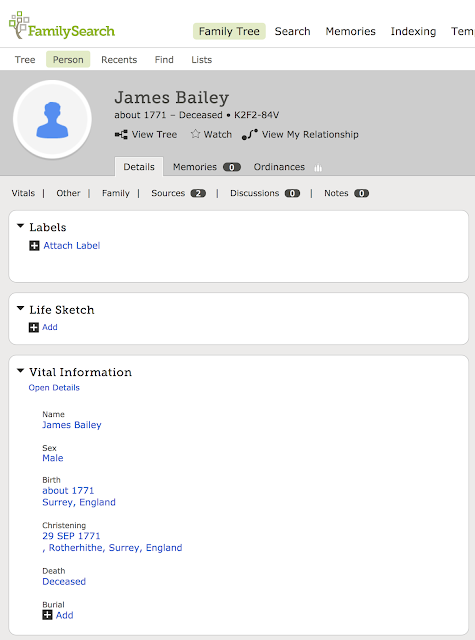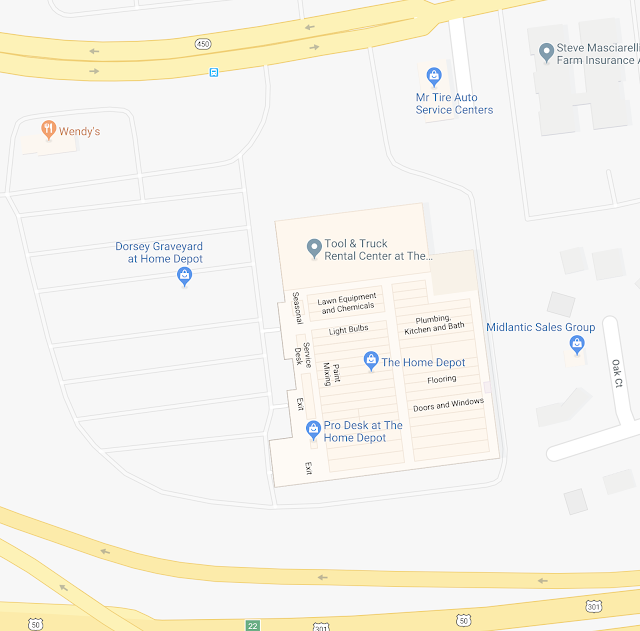You might want to start with Project Eight, Part One. I am continuing the analysis of the identity of my 5th Great-grandfather, James Bailey K2F2-84V. This post is another in the unending series of Projects I am doing to research different people in the FamilySearch.org Family Tree. See the comment at the end of this post for a further explanation of the Projects.
After spending a considerable amount of time analyzing the entries surrounding James Bailey, I decided to go back and clean up his entry. Since I started working on this individual, he has apparently picked up a couple of "Watchers." This is an interesting by-product of working on a collaborative venue such as the FamilySearch.org Family Tree. I decided I might as well join the group and decided to watch James Bailey also.
It is also apparent from the dates given to James Bailey above that the birthdate is an estimate, as it is noted in the notes to the entry. Assuming that the person was christened in his or her birth year is a usually safe assumption, but having the date there confuses the search engines and using the approximated birth date should be curtailed as much as possible. Adding the term "about" has been a standard genealogical practice for years, but again, is not a good idea from the standpoint of using online sources for research. I usually modify my search parameters to accommodate the approximations.
As I mentioned previously, there are no supporting sources for the birthdate or the christening date. Likewise, there are also no supporting documents for the places. Sussex County in England adjoins Kent. Most of the documented places for this family are either in Kent or London. As I have further noted, picking up a "James Bailey" in Sussex at this time is a stretch.
The connection between Rebecca Wallis, listed as his wife, and James Bailey is well supported. The main source is a marriage record of James Bailey and Rebecca Wallis in the Church of St. Mary Magdalene in Bermondsey, Surrey, England on 1 October 1798.
The notation on the record is that both of them are from that parish. The records show that Rebecca Wallis Bailey has a second husband and the marriage takes place in 1806. The implication is that her first husband, James Bailey, with whom she had one daughter, had died. Divorces were almost unknown in England at that time. There are no end to James Baileys in England about that time but, so far, support for the christening date of 29 September 1771 in Rotherhithe, Surrey, England has eluded me. However, I do find a James Bailey who died in Southwark St John Horsleydown, Surrey in 1803.
This looks like one of those end-of-line situations that has eluded the generations of my ancestors in their attempt to find this particular James Bailey. If looks like this one will be some time in solving.
This looks like one of those end-of-line situations that has eluded the generations of my ancestors in their attempt to find this particular James Bailey. If looks like this one will be some time in solving.
In this project, I started out by picking a somewhat random person from my ancestors or my ancestors' descendants who lived in the 20th Century from the FamilySearch.org Family Tree and to hopefully show, step-by-step, the research needed to extend that person's family tree back several generations. In this particular case, I found a direct line ancestor to use as an example. Finding a person who has no apparent ancestors in the Family Tree is relatively easy for those who lived in or into the 20th Century by much harder the further you go back in the past. To clarify this project, I will not be reserving any of the people I discover for my own Temple List, unless, as in the case with this family, I am directly related to those I find. I will simply leave the "green icons" on the Family Tree for that person's descendants to find and use for themselves. Please refrain from doing the temple work for people to whom you are not related.
Now, after I got going doing the research, I got a couple of requests to research some people further back in time. These turned out to be old, established "end-of-line" situations. Since my original idea was to demonstrate finding people, I started with easier challenges. But in any event, I may or may not find new people to add to the FamilyTree. Since the families I choose are in an "end-of-line" sort of situation independent of the time frame, there is no guarantee that I will be any more successful than the average user of the Family Tree in finding additional family members. In any event, I hope that my efforts as recorded will help either the family members or others to find more information about their ancestral families and relatives.
Why am I doing this? For the past 15 years or so, I have been helping hundreds (thousands?) of people find their ancestors. I simply intend to document the process in detail with real examples so that you can see exactly how I find family lines. I simply want to show where those "green icons" come from. Since the FamilySearch.org Family Tree is entirely cooperative, I will simply assume that when I find a family that needs some research that I am helping that family. By the way, this is Project Five of the series because I intend to do this over and over with different examples.
There is another reason why I am doing this. Because I constantly offer to help people find their ancestors and I get relatively few that take advantage of that offer. I need to spend some of my excess energy.





















































